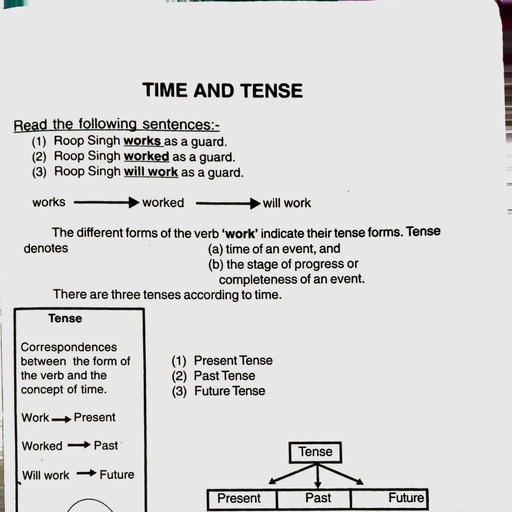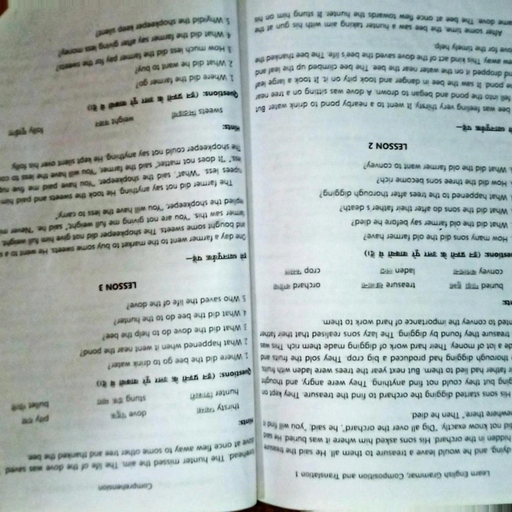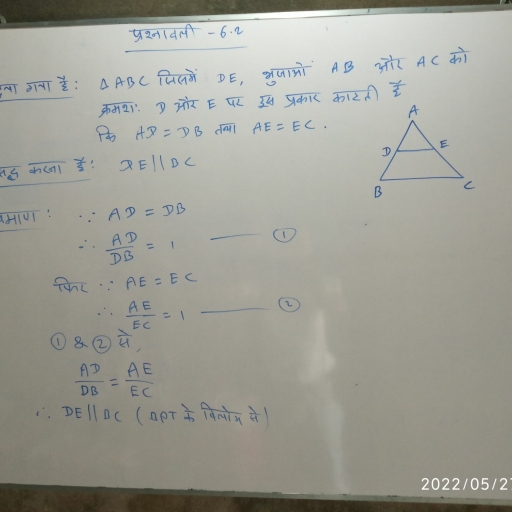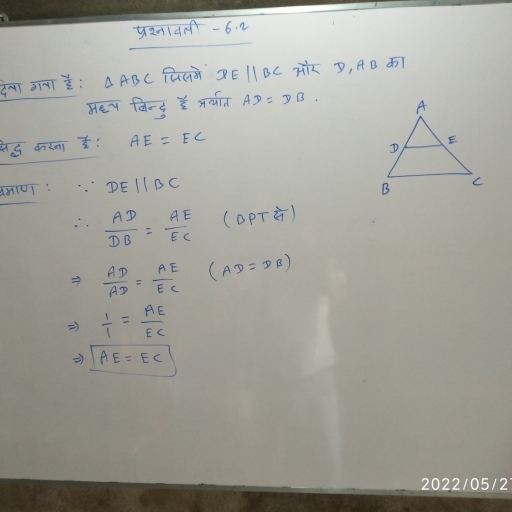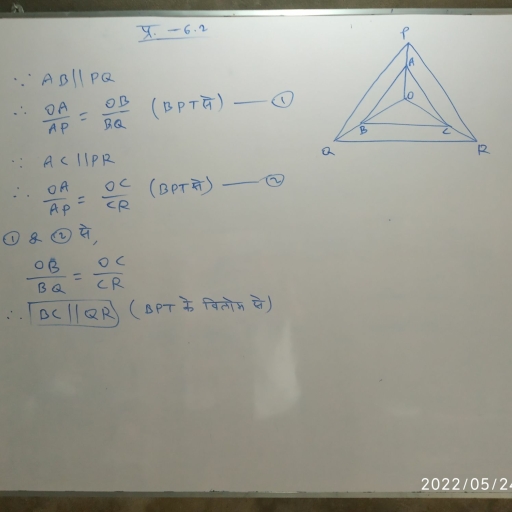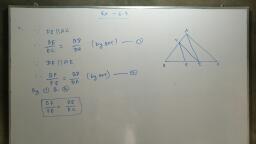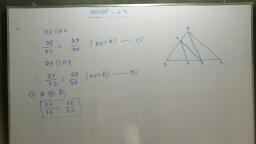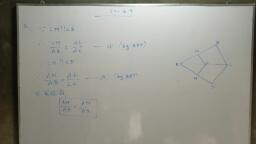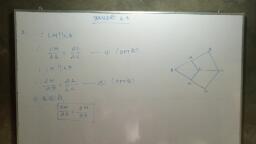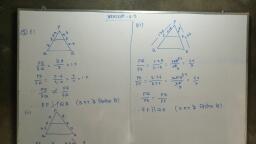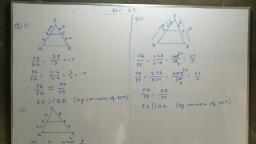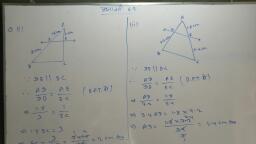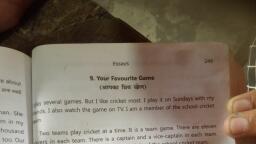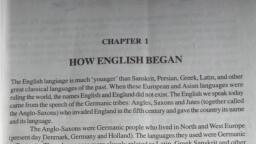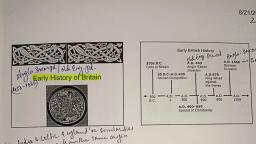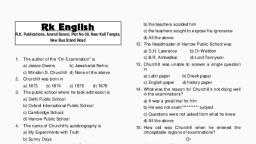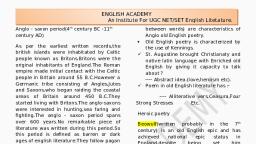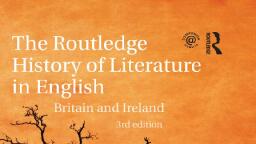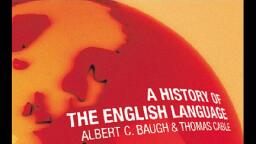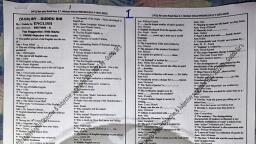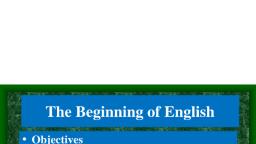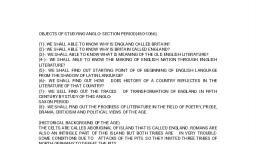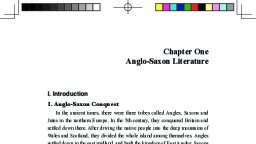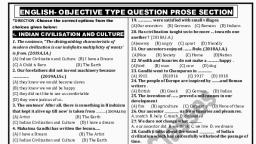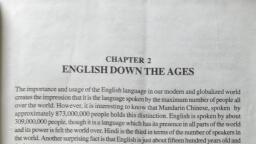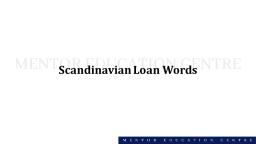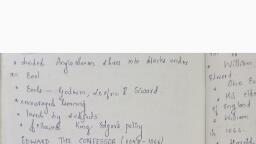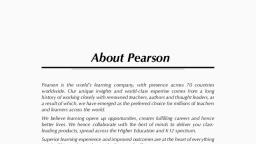Page 1 :
CHAPTER 3, , OLD ENGLISH, one of the following names: Old, by, to, refened, is, populat, The first period ip the history of English, earlier two names are more, the, However,, English, Anglo —Saxonand Anglo-Celtic., the coming of the Anglo-Saxons, with, begins, English, of, and used more often. The history, AD 1066. These two, , from Europe to mainland Britain. This period is, , from AD 449 to, , course of history. The Anglo —Saxons, dates signify two major invasions that changed the, in 449 changed Celtic Britain, invasion, their, and, Europe, were fierce, war-like tribes from, resulted in the infusion of a, 1066, AD, in, Conquest, Norman, into Germanic England. The, from Europe to mainland, large number of French words into the vocabulary of English, Britain., , difficult to describe, The relationships between the Celts and the invaders is, accurately, but they seemed to have settled down side by side in more or less peaceful, , the, contact with the Anglo —Saxonsand combined to produce seven kingdoms known as, Anglo-Saxon Heptarchy. The leadership of these kingdoms gadually passed into the hands, of the Saxons because of their better political understanding. The Celtic languages were, not used for any purpose by them, neither did these languages influence the Saxons. Therefore, , only a handful of Celtic words exist today and most of them are names of places or rivers., Some of these better known are the following., , (Place Names), Dover, Cumberland, Kent, London, York, , (Names of Rivers), Avon, Thames, Trent, Dee, Derwent., , Some traces of Britain's Celtic past are also preserved in, the first syllable of the, names of some towns and districts in present-day England., These are- Manchester,, Winchester, Worcester, Glouscester, Lichfield, Salisbury, and Exeter. Another class of Celtic, words preserved in Modern English are words connected, with religion or religious
Page 2 :
OLD ENGLISI I, , 9, , DIALECTSOF OLD ENGLISH, is a clear line of descent from the speech of the Anglo-Saxons to Modem English in, matters of sounds, vocabulary, grammar and spelling, but Old English was not a single, , unifoctu language. We can distinguish four dialects in Old English .They are Kentish,, Notthumbrian, Meteian and West Saxon. Thus, it can be said that Old English was dialectical., , This is undeßtandable because three dilTerentAnglo-Saxon tribes were involved and it, was but natural that a variety in languages existed., , SOME CHARACTERISTICS OF OLD ENGLISH, Sotne Ceatutes, , make it very difficult to lead and understand the texts of this period., , The language looks different because of its alien spelling, unfamiliar vocabulary and a, totally different grammatical structure. The writing system of OE is very different from, what we find with today. When the Anglo-Saxons came to England they used a system of, writing which was in use in the Nonhelll and Western part of Europe.(present day Germany, and Scandinavia).This wtiting system used the Runic alphabet. The Runic characters were, composed of sham straight lines without curves. Many of these letters are found on weapons;, , such as arrows, axes, knife —handles,swords ect. Some are to be seen in monuments,, jewellery and caskets made of bones, but their messages are difficult to derive as most of, them ate genetally symbolic., After the 6thCentury, the spread of Christianity led to the gradual use ofthe Roman, script, as this was the writing of the Latin religious texts. The Roman alphabet adopted by, , the Anglo-Saxons passed through some variations before it reached its present shape in, Modern English. The old Saxon forms were superseded by French characters and some, new letteß were added to the alphabet, such as Q, q, W, w, J, j after the Norman Conquest, of AD 1066., , FOREIGN INFLUENCES, , OLD ENGLISH, , stoty of English is the story of repeated inuusions of foreign elements into the English, vocabulary From the earliest times the counUy had been subjected to successive aggressions, , by fotvign invaders such as the Romans, French and Scandinavians. Earlier they brought, their own languages, but later bestowed on English a fair share of their vocabulary. In the, OE period the two major influences were Latin and Scandinavian.
Page 3 :
RAINBOW STORY OF ENGLISH, 10, , LATIN INFLUENCE ON OLD ENGLISH, existed, Perhaps no single language has influenced English as much as Latin. Words in Latin, in England before the coming ofthe Anglo-Saxons. In ancient ümes Latin had the status of, , a world language. The languages of some European countries which had come under, Roman rule had become Romanised (e.g.Gaulish became French).However, this process, of Romanisation was halted by the arrival of the Anglo-Saxons, and the collapse of the, Roman Empire. Most of the borrowed words in Latin relate to the areas in which the, supremacy of the Romans was recognized, that is Military, Agriculture and Trade and, Commerce. Some examples are: wall (from Latin Vallum), tile (from Latin Tequla), mile, (from Latin Milia Passum), and many derivatives., , About AD 600 Christianity began to spread in England together with the rise of, literacy. The Christian missionaries translated a large number of Latin texts (mostly in, Northumbrian) and made word glosses. Many of the following words in existence today, are borrowed from Latin and are related to religion; heaven, hell, God, gospel, Easter,, sin, alter, abbot, alms, angel, mass ,nun, priest etc. Other words relating to learning,, , science medicine are —history,grammatical, master, paper, school, verse, meter,, anchor, cucumber, lily, candle, plant, tiger and so on., , SCANDINAVIAN INFLUENCE ON OLD ENGLISH, The second major linguisticinvasion of English came as a result ofthe Scandinavian attacks, on England. They were the Germanic inhabitants of Norway, Sweden and, Denmark, who, one time neighbours of the Anglo-Saxons in 5thCentury Europe, were, closely related to, them in blood and language. These daring sea-faring people were, called Vikings. Viking, Age from the middle of the 8thCentury to the beginning of the, 11thCentury., , SCANDINAVIAN INFLUENCE ON OE VOCABULARY, The result of two centuries of close contact with the, Scandinavians had an unavoidable, effect on the languages ofthe Anglo-Saxons. This, influence was not immediately apparent, because of the hostile relationship between the Danes, and the Anglo-Saxons. Towards, the, end of the 9thCentury peaceful co-existence, prevailed and many Danish, words entering, English which were very basic in nature. These, words entered through, everyday interaction, 'some of these words are —birth, bank,, , bull, call, clip, die, drag,, egg, fellow, gap', give, get, guess, harbour, hit, hill, ill, kid, knife,, leg, low, meek, muck,, odd, race, raise, root, rotten, scare, score, seat, sister, sky,, sly, tight, trust, want, weak,, window.
Page 4 :
OLD ENGLISH, 11, , family names and place, Apart from this, Scandinavian borrowings are found in, not restricted to nouns,, names. It is interesting to notice that Scandinavian words were, conjunctions and other forms, verbs and adjectives. Structure words like prepositions and, pronouns, hie, hiera,, such as pronouns and adverbs were freely borrowed. Three OE, Words like both,, him were replaced by their Danish counterparts, they, their, them., , But the most, same, aloft, seemly, to till, fro, though are all Scandinavian in origin., English-'to be'., remarkable borrowing is ARE, the plural form of the most basic verb in, , touch the, Thus the Scandinavian influence on OE extended beyond the vocabulary to, grammatical system as well., , OLD ENGLISH LITERATURE, The literature of the Anglo-Saxons is of two types. The fil$t is that which was undoubtedly, , oral, brought by the Germanic tribes when they invaded England and is preserved in the, in, tradition. The second is manifest in the songs, poems and religious writings found, manuscripts produced when literacy came to England. Unfortunately, only a fragment of, Old English poetry has survived and the manuscripts are the following:-, , 1. The BEOWULF (MS), 2. The JUNIUS (MS), 3. The EXETERBOOK, , 4. The VERCELLIBOOK, The golden period of Old English literature was the era of King Alfred. He was a, scholar, soldier, law-giver and ruler. When he became king, there were not enough scholzu-s, to read the Latin service books and the early Christian literature. King Alfred brought in, teachers and scholars from abroad and he himself set out to translate many of the works in, , Latin into West Saxon, including Bead's HISTORY. The most notable work inspired by, Alfred was The Anglo-Saxon Chronicle. This book is the first book of English prose,, and the first continuous history of a European nation in its own language, The year 1066 marks the end of Old English. The Norman Conquest made England, into little more than a colony of France. French became the language of the king's court,, justice, governance and education. The language of everyday speech among the upper, class in England was French. The Normans had no interest in developing and patronizing •, a language such as English. In the absence of adequate patronage English literary writing, almost came to a standstill. However, it continued to be the language of the masses. Over
Page 5 :
RAINBOW STORY OF, , ENGLISH, , 12, , English began replacing, inter-marriages,, a period of time, due to close interaction and, The children of the nobility, schools., and, offices, French, first in the homes and later in the, in school. Thus the, French, taught, be, to, spoke English as their mother tongue and had, Moreover, England was, rulers., French, the, of, English Language survived the onslaught, Conquest., restored to English kings within 150 years of the Norman, , Exercises, 1. Write T for true and F for false statements:, a) Old English is knownalso as Anglo-Celtic English., , b) Old English was a single uniformlanguage., find, c) The Writingsystem of Old English is very different from what we, today., , the, d) Scandinavian influenceon the Old English vocabulary also affected, grammatical system., e) The era of King Alfredwas very bad for English literature., , 2. Answer very briefly:, 1., 2., 3., 4., 5., , What was the impactofthe Norman Conquest on vocabulary of English?, Name the four dialects on Old English., Write the features of the Runic characters (alphabet), Name the two major influences on the Old English., Name the four manuscripts of the Old English that have survived.

